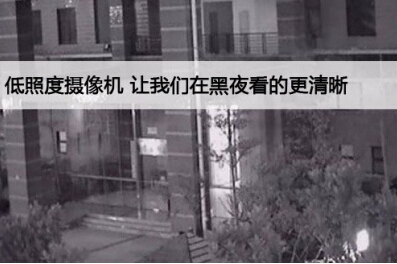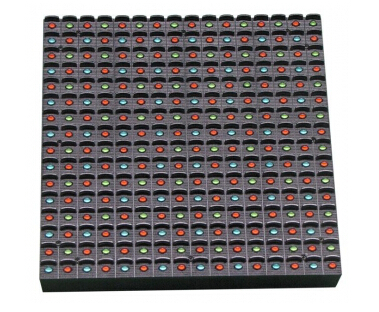Prior to the implementation of low-light and night-vision surveillance installations and product selection, it is necessary to first understand the types and characteristics of low-light and night-vision applications. Only after grasping these types of characteristics can they be properly applied to the corresponding environment. First of all, low-light camera generally refers to the ability to identify targets in a low-light environment without auxiliary lights. The principle is to use the sensor components of the camera itself, the image processing unit ISP/DSP and the optical function of the lens to achieve the common application of these underlying key technologies. The application of low-light and night-vision monitoring can produce actual performance, and its implementation is not the only one. It generally includes the following major categories.

1, the most commonly used low light high induction mode (Low-Light Mode)
Also known as low-light full-color mode, this type of camera mostly uses Super HAD, Ex-view/EXTRA-View CCD or back-illuminated COMS as the light-sensing device, and has good visible and near-infrared light response in low light environments. Cameras using this technique are also called all-weather cameras. Usually, the low light color mode can achieve low illumination of 10-2 Lux, black and white rendering up to 10-3 Lux, and infrared-assisted illumination can be used under 0 Lux, but the illumination of the latter two cases does not constitute Low-light. Low light color requirements and modes. This kind of Surveillance Camera not only can clearly identify the image, but also can maintain a certain noise value in the low-light display color screen, and does not delay the screen when low-light display is achieved through the slow shutter light accumulation mode.
2, the most convenient day color / night mode (Day / Night Mode)
Also known as the day and night model, using the principle of electronic machinery, this kind of camera gradually becomes the mainstream in the market. The low-light performance of a general day/night camera is indicated by the color 10-2Lux and IC Ron's 10-3 to 10-4Lux mode. The label of 0Lux is basically meaningless, so it is used day and night in the case of low-light night vision. Special instructions must be given when monitoring. This kind of camera utilizes black-and-white images for infrared high-sensitivity characteristics. Under specific lighting conditions, the ICT cut filter can be switched using an electromechanical circuit or it can be directly switched to black and white signals, that is, the image can be converted from color to black and white after sensing infrared light. . In the process of color/black-white line conversion, because the infrared filter is removed, the image imaging focus changes, so it is necessary to match the IR lens, so that the day and night imaging focal length is consistent to avoid image focal length blur and color performance is not correct Disadvantages. Based on this, although this type of camera has become a purchasing trend, the “disadvantage†of extra costs associated with IR lenses is unavoidable, and strictly speaking, this mode is not the best low-light and night-vision application.

3, the most indispensable IR Illumination Mode
Also known as infrared camera (IR Camera), is the best kind of low-light and night-vision applications in addition to day and night conversion camera, can also be divided into built-in IR camera IR and external IR-assisted projection lamps. Because the CCD and CMOS sensor sensitive components can sense most of the visible and infrared spectral ranges, the auxiliary infrared light illumination enables the sensor Sensor to sense sharper images without visible light illumination at night.
At the same time, the camera's photosensitive component has a higher sensitivity than the color mode in black and white mode, and can capture clearer images in a dark environment, so under the auxiliary illumination of infrared lamps, it can achieve 0 Lux environment. Condition monitoring applications. In addition, through the automatic killing device of the photoresistor, it is also possible to select black and white or day and night type cameras to increase the ability to monitor low and night vision applications.
4, the most risky slow shutter mode (Digital Slow Shutter)
Using DSS electronic slow shutter speed, letting a large amount of light through the aperture shutter accumulates a higher picture illuminance effect, also known as light or frame accumulation mode. This type of frame-accumulating camera uses a slow shutter technique to accumulate images that are blurred due to insufficient light, forming a clear image. Under the premise that the aperture is f1.2-1.4, the picture can accumulate enough illuminance frames. This technique can reduce the camera illumination to 10-4 Lux. Some articles have mentioned that this is a stupid but reliable low-light application technology, but this technology is only applicable to fixed cameras, and the need for a constant change in ambient light, otherwise it will easily lead to the screen smear delay, suitable for disabling infrared Or projectors and other static monitoring sites.
The above four categories of products can be used as the basis for the application mode of low-light and night-vision surveillance selection. Based on this, the selection of relevant products can be used for reference. After discussing the selection problems, the next step is to further discuss how the related products can be installed and constructed. Get the best results.

1, the most commonly used low light high induction mode (Low-Light Mode)
Also known as low-light full-color mode, this type of camera mostly uses Super HAD, Ex-view/EXTRA-View CCD or back-illuminated COMS as the light-sensing device, and has good visible and near-infrared light response in low light environments. Cameras using this technique are also called all-weather cameras. Usually, the low light color mode can achieve low illumination of 10-2 Lux, black and white rendering up to 10-3 Lux, and infrared-assisted illumination can be used under 0 Lux, but the illumination of the latter two cases does not constitute Low-light. Low light color requirements and modes. This kind of Surveillance Camera not only can clearly identify the image, but also can maintain a certain noise value in the low-light display color screen, and does not delay the screen when low-light display is achieved through the slow shutter light accumulation mode.
2, the most convenient day color / night mode (Day / Night Mode)
Also known as the day and night model, using the principle of electronic machinery, this kind of camera gradually becomes the mainstream in the market. The low-light performance of a general day/night camera is indicated by the color 10-2Lux and IC Ron's 10-3 to 10-4Lux mode. The label of 0Lux is basically meaningless, so it is used day and night in the case of low-light night vision. Special instructions must be given when monitoring. This kind of camera utilizes black-and-white images for infrared high-sensitivity characteristics. Under specific lighting conditions, the ICT cut filter can be switched using an electromechanical circuit or it can be directly switched to black and white signals, that is, the image can be converted from color to black and white after sensing infrared light. . In the process of color/black-white line conversion, because the infrared filter is removed, the image imaging focus changes, so it is necessary to match the IR lens, so that the day and night imaging focal length is consistent to avoid image focal length blur and color performance is not correct Disadvantages. Based on this, although this type of camera has become a purchasing trend, the “disadvantage†of extra costs associated with IR lenses is unavoidable, and strictly speaking, this mode is not the best low-light and night-vision application.

3, the most indispensable IR Illumination Mode
Also known as infrared camera (IR Camera), is the best kind of low-light and night-vision applications in addition to day and night conversion camera, can also be divided into built-in IR camera IR and external IR-assisted projection lamps. Because the CCD and CMOS sensor sensitive components can sense most of the visible and infrared spectral ranges, the auxiliary infrared light illumination enables the sensor Sensor to sense sharper images without visible light illumination at night.
At the same time, the camera's photosensitive component has a higher sensitivity than the color mode in black and white mode, and can capture clearer images in a dark environment, so under the auxiliary illumination of infrared lamps, it can achieve 0 Lux environment. Condition monitoring applications. In addition, through the automatic killing device of the photoresistor, it is also possible to select black and white or day and night type cameras to increase the ability to monitor low and night vision applications.
4, the most risky slow shutter mode (Digital Slow Shutter)
Using DSS electronic slow shutter speed, letting a large amount of light through the aperture shutter accumulates a higher picture illuminance effect, also known as light or frame accumulation mode. This type of frame-accumulating camera uses a slow shutter technique to accumulate images that are blurred due to insufficient light, forming a clear image. Under the premise that the aperture is f1.2-1.4, the picture can accumulate enough illuminance frames. This technique can reduce the camera illumination to 10-4 Lux. Some articles have mentioned that this is a stupid but reliable low-light application technology, but this technology is only applicable to fixed cameras, and the need for a constant change in ambient light, otherwise it will easily lead to the screen smear delay, suitable for disabling infrared Or projectors and other static monitoring sites.
The above four categories of products can be used as the basis for the application mode of low-light and night-vision surveillance selection. Based on this, the selection of relevant products can be used for reference. After discussing the selection problems, the next step is to further discuss how the related products can be installed and constructed. Get the best results.
Access Control System,Intelligence Applicance,Intelligence Electric,Access Control
ChangChun E-vida Technology Co.,ltd , https://www.evidatec.com